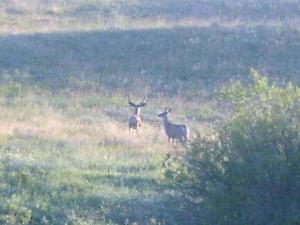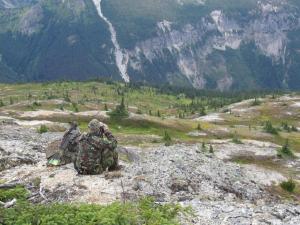Scouting for Deer
In your deer hunt, scouting plays the most critical role. A little time spent in the field before the beginning of the hunting season can make a huge difference in the success rate of the hunt. Deer scouting is an art that consists of locating and interpreting deer signs.
The deer-scouting season lies just before the hunting season. Scouting is done so that you may know where to find the deer when you start your hunt. You need to begin scouting at least a month before the onset of the season and note the deer activity around the edges of the fields. Many times these clear-cut areas are overlooked.
Deer feeding spots can also be found on stretches of natural grasses.

buck
HTAT member Sheldon Arams sent in this photo of his mule deer scouting success.
Forest mast being favored food, deer can be found where it is abundant. While scouting observe and take note of the type of mast crop available on the trees. A good pair of binoculars provides great service in letting you do this. One important tree to check is the white oak as it is a prime source of deer food. In the South, white oaks bloom to give good acorn mast only every alternate year. However, most of the mast crops begin to fall from mid September that marks the beginning of the bow season. The mast continues to fall till the end of the following month. Focusing on the food chain is important in deer scouting. If you miss on this, you miss on the most crucial factor for successful deer hunting.
It is also very important to identify travel areas of deer while on the scouting trip. Scout for locating travel routes used by deer to move from bedding to feeding areas. Remember that deer instinctively select paths that offer the minimum resistance and plenty of cover for their travel. This can help you to focus your scouting to such areas. It is common for deer to travel on the same routes year after year. When scouting in winter or early spring the trails formed by deer show up prominently in the barren wood belts. You could set up a game scouting camera on one of these areas.
If scouting for mule deer, they will be residing in the high country until the rut begins, you will need to hike up to high elevations and watch for movement with 10 power binoculars. Look for traveling routes and patterns of the mule deer. Keep an eye out for where they bedding grounds are because that is where you best chance to bag a cagey early season mule deer buck lies. Keep glassing the timber pockets as they will most likely move around cover. If scouting white tail deer look at farmer’s different pastures and find natural pathways and treed pockets that will likely hold white tails while they are browsing between fields.

Glassing the high country
on the right, glassing for mule deer in the high country.
Pre-season scouting for deer also involves looking for some of the multiple deer signs that include deer poop, tracks, rubs and scrapes. Rubs are found on small trees where bucks rub their velvet-covered antlers to clean them of the velvet. Scrapes are places where they scrape away vegetation and leaves to urinate for establishing a claim to the area as a challenge to other bucks.
Be careful that you do not contaminate a potential area while scouting. Deer have an uncanny ability of detecting human scent and even a tiny whiff will put them off a spot never to visit it again. Therefore, you have to make sure that you make yourself as scent free as possible before you go deer scouting. Use any good scent control product available in the market. Use them also while washing the clothes you put on during your deer-scouting trip.
Another important deer scouting tip is to use different doe calls while scouting. There are many good products to imitate different calls that are available on the market and should be essential parts of deer scouting equipment. Deer communicate all the year round and if a doe is spotted at a distance 300 feet or so you may grunt to her. More often than not, this will make her come looking for company. After coming, even if she moves off on finding nothing, later on this may lead a buck following her scent to the place. When you call from near the tree stand you intend to use, it makes the deer walk past it. Scenting the does going through the place gives the bucks that follow an easy feeling going around the stand.
Game scouting cameras also are great scouting aids. There is an array of scouting cameras from various manufacturers available in the market. They help locate areas visited by deer and can provide time specific pictures of the area. They take pictures when they sense movement or they take pictures at set intervals.
Below is a video of a herd of mule deer in Merritt BC during the spring of 2012:

